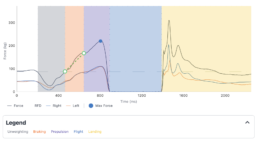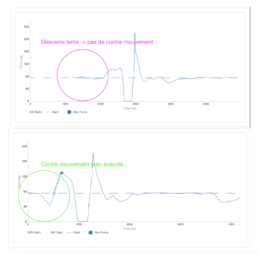In this article you will find the different ways of proceeding to achieve an optimal jump and, on the other hand, all the scenarios concerning bad executions that give zero results.
We will look at CMJ, Drop Jump and Squat Jump.
- CMJ -
Counter-movement jumps execution
Your patient should follow these instructions to execute a CMJ (Counter Movement Jump):
- Start by standing with their feet shoulder-width apart and their toes pointing slightly outward.
- At the end of the countdown, instruct them to bend their knees and lower their body into a squatting position while keeping their back straight and chest up. This is the “counter movement” phase.
- Encourage them to quickly reverse the movement and explode upward, extending their hips, knees, and ankles simultaneously.
- They should aim to obtain maximum height.
- Guide them to land softly by flexing their hips, knees, and ankles to absorb the impact.
- After landing from the jump, instruct them to stay on the plateform until the end of the assessment.
Proper CMJ signal
If your CMJ signal doesn’t look like this it’s probably because of a wrong execution.

Fail cases
Jump too early
When a person jumps too early, it means they initiate the movement before the end of the countdown. This leads to an incomplete force-ground reaction plot. As a result, the force-ground reaction plot may not accurately capture the complete force profile and give you the data analysis.
Mouvement during the weighting phase
The force-ground reaction plot can appear incorrect due to excessive movement during the weighting phase, it can indeed affect the accuracy of the plot.
Excessive movement during the weighting phase refers to excessive shifting, swaying, or lateral movement of the body before the jump (during the countdown). This instability and variability in body position can lead to inconsistent ground contact and force distribution. As a result, the force-ground reaction plot may exhibit irregular patterns or fluctuations that do not align with the expected force production.
To address this issue and improve the accuracy of the force-ground reaction plot, it is important to focus on maintaining stability and minimizing excessive movement during the weighting phase. Encourage your patient to practice proper body control and alignment, emphasizing a stable and centered position before initiating the jump.
No countermovement
The force-ground reaction plot can appear incorrect because no countermovement or unweighting phase was detected.
The countermovement refers to the initial downward phase of a jump where the body pre-stretches the muscles before the upward movement. This countermovement is crucial for optimizing force production and jump height.
If no countermovement is detected, it suggests that the person did not properly descend before initiating the upward jump. As a result, the force-ground reaction plot may not accurately capture the expected force profile.
💡 If you don’t want your patient to do the downward phase before the jump you may want him to perform a squat jump. you can check this article to know which jump exercise you should choose to assess your patient or athlete.

To address this issue and improve the accuracy of the force-ground reaction plot, it is important to ensure that your patient executes the countermovement and unweighting phase properly here are some insights :
- Encourage them to perform a distinct downward movement before the jump, emphasizing the importance of the countermovement to pre-stretch the muscles.
- Instruct them to focus on achieving a brief unweighting phase at the bottom of the countermovement.
- Emphasize proper technique and timing, ensuring that they execute the jump with an effective countermovement and unweighting phase to optimize force production.
- Drop Jump -
Drop jump execution
Your patient should follow these instructions to perform a Drop Jump:
- Step on an elevated surface such as a box or step. The height of the surface can vary depending on their experience and capabilities.
- Instruct them to step off the surface and land right after the countdown. They should focus on landing with good form and proper mechanics. They should land softly and quietly by flexing their hips, knees, and ankles to absorb the impact.
- As soon as they land, instruct them to immediately explode upward by extending their hips, knees, and ankles in a powerful and explosive jump.
- Aim to jump as high as possible while focusing on an explosive and quick movement.
- After landing from the jump, instruct them to stay on the plateform until the end of the assessment.
Proper DJ signal
If your DJ signal doesn’t look like this it’s probably because of a wrong execution.

Fail cases
Your patient didn’t jump after the landing
The force-ground reaction plot appears incorrect because the patient did not jump after landing
In a drop jump, the primary goal is to land and immediately perform an explosive jump. If the patient does not execute the reactive jump following the landing, it means they did not transition from the landing phase to the upward jump phase. This can result in an incomplete force-ground reaction plot that does not capture the desired force profile.
💡 if you don’t want your patient to perform a jump right after the landing, you may want to do a landing assessment, you can find this assessment by searching for “Bipodal Landing” or “Single leg landing” according to what you want to do
- Squat Jump -
Squat jump execution
Your patient should follow these instructions to perform a Squat Jump:
- Start by standing with their feet shoulder-width apart and their toes pointing slightly outward.
- Instruct them to bend their knees and lower their body into a squatting position, keeping their back straight and chest up.
- Encourage them to lower their hips until their thighs are parallel to the ground or as low as their mobility allows.
- When the countdown is finished, Instruct them to explode upward as forcefully as possible, without doing any downward movement, extending their hips, knees, and ankles simultaneously.
- Encourage them to jump as high as they can while maintaining control and good form.
- After landing, instruct them to stay on the plateform until the end of the assessment.
Proper SJ signal
If your SJ signal doesn’t look like this it’s probably because of a wrong execution.

Fail cases
Jump too early
When a person jumps too early, it means they initiate the movement before the end of the countdown. This leads to an incomplete force-ground reaction plot. As a result, the force-ground reaction plot may not accurately capture the complete force profile and give you the data analysis.
Mouvement during the weighting phase
The force-ground reaction plot can appears incorrect due to excessive movement during the weighting phase, it can indeed affect the accuracy of the plot.
Excessive movement during the weighting phase refers to excessive shifting, swaying, or lateral movement of the body before the jump (during the countdown). This instability and variability in body position can lead to inconsistent ground contact and force distribution. As a result, the force-ground reaction plot may exhibit irregular patterns or fluctuations that do not align with the expected force production.
To address this issue and improve the accuracy of the force-ground reaction plot, it is important to focus on maintaining stability and minimizing excessive movement during the weighting phase. Encourage your patient to practice proper body control and alignment, emphasizing a stable and centered position before initiating the jump.
Countermovement detected
The force-ground reaction plot of a squat jump appears incorrect because the patient performed a countermovement.
While performing a squat jump your patient should start the movement in a squatting position, after the countdown he should explode upward as forcefully as possible, without doing any downward movement.
💡 if you want your patient to do the downward phase before the jump you may want him to perform a countermovement jump, you can check this article to know which jump exercise you should choose to assess your patient or athlete.
